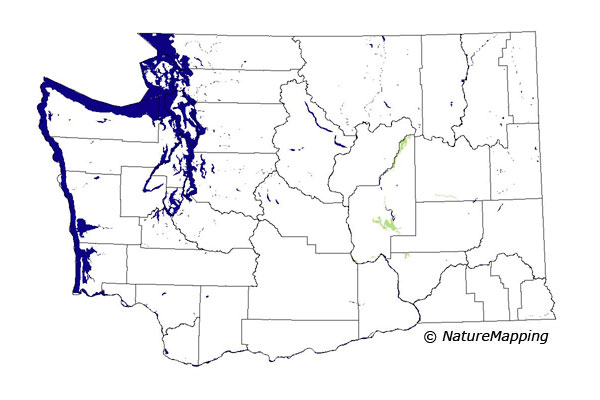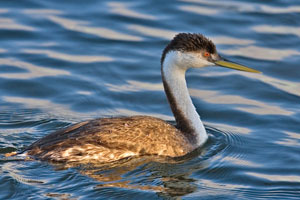


Western Grebe (Aechmophorus occidentalis) Description: The Western Grebe is the largest of the North American grebes. Sexes are similar in that they both have a long, slender neck and bill and their feet are far back of the body. The head, neck, and body are a blackish brown color from above, and white from below. The Western Grebe has a dull yellow or olive-colored bill and red eyes surrounded by dark coloration. In flight a white wing stripe is exposed. 
Length: 20-24 inches.
Calls:
The call is a High-pitched "crreeet-crreeet." Range / Habitat: The Western Grebe is commonly found from Canada through California, and sometimes in Mexico. It usually occurs in the great plains and western states, but occasionally can be found in the eastern half of the United States. It usually stays on prairie lakes in British Columbia and California, and sometimes as far down as Mexico. In the winter the Western Grebe lives on the Pacific coast. It is a migratory bird found on temperate coastal, freshwater lakes. During the breeding season it lives on large lakes with dense areas of emergent vegetation or thick mats of floating aquatic plants. In migration, the Western Grebe is found on large, deep lakes. Click the range map to learn more about the distribution of Western Grebes in Washington. 
Diet: As a carnivore, it mostly eats fish, but also gleans the water's surface for insects, mollusks, and crustaceans. The Western grebe is an aggressive hunter. It dives under the water and spears fish with its long bill. Behavior: The courtship display of the Western Grebe is among the most elaborate breeding rituals of North American wildlife. During the 'weed dance,' the male and female both raise their torsos gently out of the water, caressing each other with aquatic vegetation held in their long, rapier-like bills. The pair's bond is fully reinforced by the 'rushing' phase, during which the birds glance at one another before exploding into a sprint across the water's surface. Each grebe stands high, with its wings held back and its cobra-like head and neck rigid, until the race ends with the pair breaking the water's surface in a headfirst dive. Similar Species: Double-crested Cormorant: under parts are not clean white. Common Loon: shorter, stocky neck. Eared, Homed and Red-necked grebes: much smaller. Clark's Grebe: white around the eyes; orange-yellow bill; species ranges overlap in the Great Plains. Did you know? The mating display of the Western Grebe is among the most complicated of all. During the 'weed dance,' the male and female both raise their chest gently out of the water and then rub each other with water plants in their long bills. Then comes the 'rushing' phase when the birds look at each other before exploding into a sprint across the water's surface. Each grebe stands high, with its wings held back and its cobra-like head and neck rigid. The race ends with the pair diving head first into the water.
Animal silhouettes available to purchase » Photos: Natures Pics Home | About Us | How to Participate | Biodiversity Modules | Projects | Maps | News | Resources |